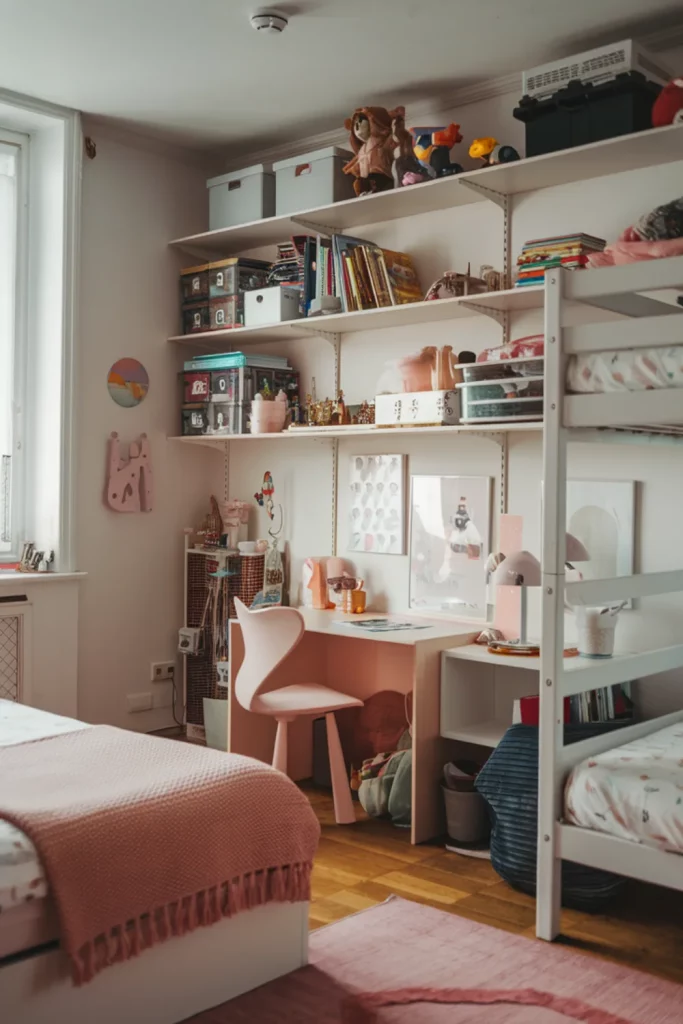The Sibling Room Sharing – Tips, Benefits & Challenges 2025

So you’re wondering about siblings sharing a room? Let’s get started!
Sharing a room is like peanut butter and jelly—sometimes perfect, sometimes a bit messy. It can impact their relationship, skills, and daily life in ways you never thought.
Enter the world of shared sibling spaces. Where bonds are formed, challenges are tackled like a ninja, and memories are made that will last forever.
Are you ready to dive into this ocean of sibling sleepovers and secret pillow fort meetings? Let’s go!

Can Siblings Share a Room?
Yes, they can.
Sharing a space brings siblings closer together. They spend more time together, learn to share, practice empathy, and respect each other’s space.
It also prepares them for future shared living situations. It can simplify bedtime routines and free up space in the house.
But it’s not all sunshine and rainbows. Lack of personal space, confusion between playtime and bedtime, and sleep disruptions must be considered.
Rules and boundaries can fix these hiccups and make room sharing a positive.
Key Points:
- Bonding: More time together = stronger bond.
- Life Skills: They learn to share, empathize, and respect space.
- Preparation: Future shared living situations won’t be a shock.
- Efficiency: Simplified bedtime routines and extra space are a bonus.
- Challenges: Limited personal space, bedtime confusion, and sleep disruptions.
- Solutions: Rules and boundaries are key to a happy living space.
While sharing a room poses its challenges, it can be a positive, healthy experience for siblings if managed thoughtfully.
Sibling Room Challenges
Sharing a room with a sibling is like trying to put two fish in a small bowl – eventually, it gets crowded and someone will start flopping around. One of the biggest issues is the lack of personal space and privacy. As kids get older they need their own space to chill and be alone. Without this, you may see more squabbles and personal space invasion.
Another snag is playtime and bedtime. Imagine trying to sleep while your sibling is still launching imaginary rockets. This mix can mess with bedtime routines and lead to restless nights and cranky mornings.
Age difference, sleep schedules, how well they get along, room size, and even gender can throw in extra wrenches. An early sleeper paired with a night owl? A recipe for disaster. Parents need to think about all these factors and set some ground rules to keep the peace.
- Personal spaces
- Bedtime vs playtime
- Age, sleep habits, sibling relationship, room size, gender
- Clear rules and boundaries
It’s not easy but it doesn’t have to be a war.
Tips for Sharing a Room with a Sibling
Sharing a room with a sibling has its pros and cons. On the plus side, it can strengthen bonds and social skills. But let’s be real, sleep disruptions will happen. Parents must weigh the children’s relationship, age gap, room size, and storage.
Get to Know Their Relationship
First off, think about how well your kids get along. Siblings who are BFFs will share a room way better than those who can’t stand each other.
Mind the Age Gap
Another thing to consider is the age difference. Kids who are close in age will find it easier to share a room because their interests and routines will align a bit more.
Room Rules
Set clear room rules, carve out individual spaces, and stick to a bedtime routine to avoid problems. Think of it as running a tight ship – everyone must know their role.
Having rules makes a big difference. Like:
- Share the toys fairly
- Respect each other’s space
- Keep the room clean
Talk to Your Kids
Communication and preparation is key. Talk to your kids about their feelings, likes, and dislikes. Know your family circumstances and adjust as needed. Age and sleep needs should guide the bedtime plans and house rules.
Schedule and Routines
Think about their daily activities and sleep patterns. Having bedtime routines that cater to their individual needs will help keep the peace and make sure everyone gets enough sleep.
With a bit of thought and planning siblings sharing a room can be a good thing. After all who wouldn’t want a built-in buddy for midnight whispers and secret handshakes?
Decorating the Shared Space
Let your kids decorate their own areas. Personal touches like favorite colors and decorations will give them a sense of ownership and reduce conflicts over shared decor.
Preparing for Room Sharing
Start by having sleepovers or playdates to get them used to sharing a space. Designate quiet times for them to have structured breaks and chill in their own way.
What to Do If Siblings Are Touching Each Other?
Oh, sibling dynamics! Sometimes it feels like they’re reenacting a soap opera, and not in a fun way. If your kiddos cross a line and touch inappropriately, it’s time to play referee with a calm, collected demeanor. No shouting as you’re the zen master here.
Create Safe Spaces and Educate: Think of yourself as a body-safety guru. Set up an inviting environment that says, “Hey, we’re all about respect and consent here!” Supervise gently, and sprinkle in lessons about boundaries like you’re seasoning a delicious stew. A little bit goes a long way.
Open the Channels of Communication: Be the open book all parents aspire to be—available and approachable. Encourage talking, not just with you but with other adults in their lives. And if things are serious, don’t hesitate to call in reinforcements. No cape is required just some trusted resources, especially if the situation involves sexual trauma.
Redirect and Prepare for Safe Experiences: Kids are curious creatures, after all. When they wander off the path, give them a gentle nudge back in the right direction. It’s like redirecting a GPS—no need for drama, just guide them where they need to go.
Establish Rules with a Family Safety Plan: Sibling rules aren’t just for who gets the remote. Set clear boundaries to prevent any touchy situations (pun intended). Family meetings can be fun. Honestly!
Resources to the Rescue: Books like Educate2Empower Publishing, or sites like Parenting Safe Children are treasure troves of wisdom. Dive in for ideas and guidance!
Key Points:
- Handle inappropriate touch situations with your best “calm and collected” hat!
- Build environments where safety and respect are the name of the game.
- Encourage open chats with all the grown-ups in their world. Help’s a holler away if needed!
- Guide kids towards safe experiences, and set them back on track if they stray.
- Establish a safety rulebook in the family to keep boundaries crystal clear.
- Lean on helpful resources for all the body-safety guidance you can get.
Remember, parenting is like being a circus ringmaster. Keep the show on the road with empathy, a dash of humor, and well-aimed guidance!
How Old Before Separating Kids’ Rooms?
Deciding when to give kids their own rooms is a choice that depends on each family’s situation.
For opposite-sex siblings, many parents think about separate rooms around age 6 or 7. At this age, kids start craving privacy and some independence, especially as they near puberty.
On the flip side, same-sex siblings might share a room for longer, finding comfort in each other’s company.
Sometimes, you may need to separate kids temporarily—perhaps for sleep training or if one child’s sleep habits disturb the other.
In the end, the best time to separate kids into their own rooms hinges on your family’s specific needs and dynamics.
Remember, every family is different, and what works for one might not work for another. So, take your time and figure out what feels right for your crew.
Sister and Brother Bedroom Design Ideas

Designing a shared bedroom for a sister and brother is like trying to fit two puzzle pieces together that don’t quite match. You need to find a balance between their individuality and a cohesive and functional space.
First, think about furniture. Use pieces with storage to make every inch count, especially in smaller rooms. That way you can keep clutter at bay and have room to play.
Put the beds on opposite walls. This will give each child their own bit of the room and some personal space. Add in some wall sconces or tall lamps to create cozy reading nooks where they can curl up with a book.
Yes, there will be difficulties. Gender and age differences will make it a bit tricky. But by aiming for a harmonious space that works for both siblings, you can create a shared bedroom that respects each child’s tastes and needs.
Key points:
- Design the shared bedroom with both sister and brother in mind for a cohesive space.
- Use furniture with storage to make the most of the room space, especially in small rooms.
- Put the beds on opposite walls and add wall sconces for reading nooks.
- Overcome the challenges of gender and age differences by creating a balanced and peaceful space.
- Create a functional bedroom for both siblings’ styles and needs.
Finding the right blend of functionality and personal touch can make their shared room a place they both love.
Brother and Sister Sharing a Room at a Hotel
Brother and sister sharing a room at a hotel? It’s more common than you’d think, even for families with adult children.
Is your husband worried about the sleeping arrangements? No problem! Just ask for twin beds or a room with a bit more privacy.
Splitting a room with two beds? Far easier on the wallet than shelling out for separate rooms. Plus, it shows the family’s ready to bend a bit to ensure everyone has a grand time.
This nifty setup turns rooming challenges into a frugal, stress-free solution, perfect for those mindful of budget constraints.
Flexibility in room preferences? It’s not just smart but it makes the stay delightful for everyone.
FAQs
At What Age Should Siblings Stop Sharing a Room?
Navigating room-sharing rules can feel like walking a tightrope. While many suggest giving children their own space after age 10, every family’s situation is unique, and life doesn’t always cooperate with guidelines.
Maybe your house isn’t big enough, or maybe your kids enjoy late-night chats too much to separate! Whatever the case, keeping those important lines of communication open is key.
Is it Normal for a Brother and Sister to Share a Bedroom?
Yes! Some might think twice but it’s totally normal for siblings to share a room. Think of it as double the love and laughter under one roof. Sharing a room doesn’t just save space but it creates a cozy space where memories are made.
And any worries about disturbances are often outweighed by the sibling love and support you get in such proximity. Imagine bedtime stories becoming epic adventures and whispers of dreams chasing the moonlight. A shared room is a playground where bonds are formed and strengthened.
At What Age Do Kids Need Their Own Rooms?
Opposite-sex siblings usually get their own rooms around age 6 or 7. At this stage, as they enter elementary school, kids start to crave privacy and individuality. It’s like they’re building their own forts of independence and personal space.
Having their own room gives each child their own space. It’s their sanctuary, where they can set up boundaries and have autonomy. Imagine it as their own clubhouse, where no sibling can enter without a secret knock. It’s not just independence they’ll get but also a sense of self.
It’s not just about separation; it’s about giving each child their own space to be themselves. And who knows, maybe less fighting over who gets the top bunk!
